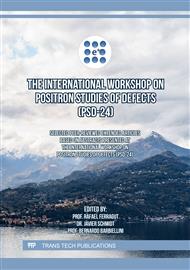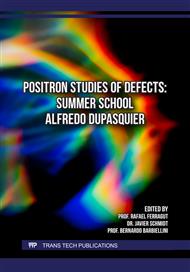[1]
Filip Tuomisto and Ilja Makkonen. Defect identification in semiconductors with positron annihilation: Experiment and theory. Rev. Mod. Phys., 85:1583-1631, Nov 2013.
DOI: 10.1103/revmodphys.85.1583
Google Scholar
[2]
Ilja Makkonen and Filip Tuomisto. Perspective on defect characterization in semiconductors by positron annihilation spectroscopy. J. Appl. Phys., 135(4):040901, 01 2024.
DOI: 10.1063/5.0180024
Google Scholar
[3]
E. Boroński and R. M. Nieminen. Electron-positron density-functional theory. Phys. Rev. B, 34:3820-3831, 1986.
DOI: 10.1103/physrevb.34.3820
Google Scholar
[4]
K. O. Jensen and A. B. Walker. Non-local positron-electron density functional theory and the positron surface state. Journal of Physics F: Metal Physics, 18(12):L277, dec 1988.
DOI: 10.1088/0305-4608/18/12/002
Google Scholar
[5]
Anna Rubaszek. Electron-positron enhancement factors at a metal surface: Aluminum. Phys. Rev. B, 44:10857-10868, Nov 1991.
DOI: 10.1103/physrevb.44.10857
Google Scholar
[6]
Vincent Callewaert, Rolando Saniz, Bernardo Barbiellini, Arun Bansil, and Bart Partoens. Application of the weighted-density approximation to the accurate description of electron-positron correlation effects in materials. Phys. Rev. B, 96:085135, Aug 2017.[7] W. M. C. Foulkes, L. Mitas, R. J. Needs, and G. Rajagopal. Quantum Monte Carlo simulations of solids. Rev. Mod. Phys., 73:33-83, Jan 2001.
DOI: 10.1103/physrevb.96.085135
Google Scholar
[8]
A. Harju, B. Barbiellini, S. Siljamäki, R. M. Nieminen, and G. Ortiz. Correlation effects in positron-electron systems: A quantum Monte-Carlo study. Journal of Radioanalytical and Nuclear Chemistry, 211(1):193-202, 1996.
DOI: 10.1007/bf02036273
Google Scholar
[9]
E. Boroński. Positron-electron annihilation rates in an electron gas studied by variational Monte Carlo simulation. Europhysics Letters, 75(3):475, jul 2006.
DOI: 10.1209/epl/i2006-10134-5
Google Scholar
[10]
N. D. Drummond, P. López Ríos, R. J. Needs, and C. J. Pickard. Quantum Monte Carlo study of a positron in an electron gas. Phys. Rev. Lett., 107:207402, Nov 2011.
DOI: 10.1103/physrevlett.107.207402
Google Scholar
[11]
Y. Dong, L. Deng, Y. H. Li, M. Luo, J. D. Liu, H. J. Zhang, and B. J. Ye. Quantum Monte Carlo study of correlation energy and pair correlation function at various electron-positron density ratios: Accurate calculation of positron annihilation lifetimes in solids. Phys. Rev. B, 109:104104, Mar 2024.
DOI: 10.1103/physrevb.109.104104
Google Scholar
[12]
Robert Jastrow. Many-body problem with strong forces. Phys. Rev., 98:1479-1484, Jun 1955.
DOI: 10.1103/physrev.98.1479
Google Scholar
[13]
N. D. Drummond, M. D. Towler, and R. J. Needs. Jastrow correlation factor for atoms, molecules, and solids. Phys. Rev. B, 70:235119, Dec 2004.
DOI: 10.1103/physrevb.70.235119
Google Scholar
[14]
Nicholas Metropolis, Arianna W. Rosenbluth, Marshall N. Rosenbluth, Augusta H. Teller, and Edward Teller. Equation of State Calculations by Fast Computing Machines. The Journal of Chemical Physics, 21(6):1087-1092, 06 1953.
DOI: 10.1063/1.1699114
Google Scholar
[15]
Tosio Kato. On the eigenfunctions of many-particle systems in quantum mechanics. Communications on Pure and Applied Mathematics, 10(2):151-177, 1957.
DOI: 10.1002/cpa.3160100201
Google Scholar
[16]
Russell T Pack and W. Byers Brown. Cusp Conditions for Molecular Wavefunctions. The Journal of Chemical Physics, 45(2):556-559, 07 1966.
Google Scholar
[17]
M.P. Nightingale. In M. P. Nightingale and C. J. Umrigar, editors, Quantum Monte Carlo Methods in Physics and Chemistry, volume 525 of NATO Advanced-Study Institute, Series C: Mathematical and Physical Sciences, page 1. Kluwer Academic, Dordrecht, 1999.
DOI: 10.1007/978-94-011-4792-7
Google Scholar
[18]
K. A. Simula, J. Härkönen, I. Zhelezova, N. D. Drummond, F. Tuomisto, and I. Makkonen. Quantum Monte Carlo study of Doppler broadening of positron annihilation radiation in semiconductors and insulators. Phys. Rev. B, 108:045201, Jul 2023.
DOI: 10.1103/physrevb.108.045201
Google Scholar
[19]
Dario Bressanini, Massimo Mella, and Gabriele Morosi. Positronium chemistry by quantum Monte Carlo. I. Positronium-first row atom complexes. The Journal of Chemical Physics, 108(12):4756-4760, 03 1998.
DOI: 10.1063/1.475887
Google Scholar
[20]
Dario Bressanini, Massimo Mella, and Gabriele Morosi. Positron chemistry by quantum Monte Carlo. II. Ground-state of positron-polar molecule complexes. The Journal of Chemical Physics, 109(5):1716-1720, 08 1998.
DOI: 10.1063/1.477216
Google Scholar
[21]
Dario Bressanini, Massimo Mella, and Gabriele Morosi. Positron and positronium chemistry by quantum Monte Carlo. III. Ground state of [OH,Ps],�[CH,Ps], and [NH2,Ps] complexes. The Journal of Chemical Physics, 109(14):5931-5934, 10 1998.
DOI: 10.1063/1.477216
Google Scholar
[22]
Massimo Mella, Gabriele Morosi, and Dario Bressanini. Positron and positronium chemistry by quantum Monte Carlo. IV. Can this method accurately compute observables beyond energy? The Journal of Chemical Physics, 111(1):108-114, 07 1999.[23] Massimo Mella, Gabriele Morosi, Dario Bressanini, and Stefano Elli. Positron and positronium chemistry by quantum Monte Carlo. V. The ground state potential energy curve of e+LiH. The Journal of Chemical Physics, 113(15):6154-6159, 10 2000.
DOI: 10.1063/1.1308550
Google Scholar
[24]
Tatsuo Saito, Masanori Tachikawa, Chikaomi Ohe, Kaoru Iguchi, and Kazunari Suzuki. Binding energy of PsCH3 system by quantum Monte Carlo and ab initio molecular orbital calculations. The Journal of Physical Chemistry, 100(15):6057-6060, 1996.
DOI: 10.1021/jp9525292
Google Scholar
[25]
Yukiumi Kita, Ryo Maezono, Masanori Tachikawa, Mike Towler, and Richard J. Needs. Ab initio quantum Monte Carlo study of the positronic hydrogen cyanide molecule. The Journal of Chemical Physics, 131(13):134310, 10 2009.
DOI: 10.1063/1.3239502
Google Scholar
[26]
Yukiumi Kita, Ryo Maezono, Masanori Tachikawa, Mike D. Towler, and Richard J. Needs. Ab initio quantum Monte Carlo study of the binding of a positron to alkali-metal hydrides. The Journal of Chemical Physics, 135(5):054108, 08 2011.
DOI: 10.1063/1.3620151
Google Scholar
[27]
J. Mitroy and G. G. Ryzhikh. The stability and structure of Li+Ps2 and Na+Ps2. Journal of Physics B: Atomic, Molecular and Optical Physics, 32(21):L621, Nov 1999.
Google Scholar
[28]
G. F. Gribakin, J. A. Young, and C. M. Surko. Positron-molecule interactions: Resonant attachment, annihilation, and bound states. Rev. Mod. Phys., 82:2557-2607, Sep 2010.
DOI: 10.1103/revmodphys.82.2557
Google Scholar
[29]
Gino Cassella, W. M. C. Foulkes, David Pfau, and James S. Spencer. Neural network variational Monte Carlo for positronic chemistry. Nature Communications, 15(1):5214, 2024.
DOI: 10.1038/s41467-024-49290-1
Google Scholar
[30]
Jaroslav Hofierka, Brian Cunningham, Charlie M. Rawlins, Charles H. Patterson, and Dermot G. Green. Many-body theory of positron binding to polyatomic molecules. Nature, 606(7915):688-693, Jun 2022.
DOI: 10.1038/s41586-022-04703-3
Google Scholar
[31]
Jorge Charry, Márcio T. do N. Varella, and Andrés Reyes. Binding matter with antimatter: The covalent positron bond. Angewandte Chemie International Edition, 57(29):8859-8864, 2018.
DOI: 10.1002/anie.201800914
Google Scholar
[32]
Shumpei Ito, Daisuke Yoshida, Yukiumi Kita, and Masanori Tachikawa. First-principles quantum Monte Carlo studies for prediction of double minima for positronic hydrogen molecular dianion. The Journal of Chemical Physics, 153(22):224305, 12 2020.
DOI: 10.1063/5.0022673
Google Scholar
[33]
Dario Bressanini. The stability of e+(H)2. The Journal of Chemical Physics, 154(22):224306, 06 2021.
Google Scholar
[34]
Dario Bressanini. Two positrons can form a chemical bond in (PsH)2. The Journal of Chemical Physics, 155(5):054306, 08 2021.
DOI: 10.1063/5.0059721
Google Scholar
[35]
Dario Bressanini. e+(PsH)2: A three-positron molecule with a positronic chemical bond. The Journal of Chemical Physics, 156(15):154302, 04 2022.
DOI: 10.1063/5.0089157
Google Scholar
[36]
Jorge Charry, Félix Moncada, Matteo Barborini, Laura Pedraza-González, Márcio T. do N. Varella, Alexandre Tkatchenko, and Andrés Reyes. The three-center two-positron bond. Chem. Sci., 13:13795-13802, 2022.
DOI: 10.1039/d2sc04630j
Google Scholar
[37]
Jorge Alfonso Charry Martinez, Matteo Barborini, and Alexandre Tkatchenko. Correlated wave functions for electron-positron interactions in atoms and molecules. Journal of Chemical Theory and Computation, 18(4):2267-2280, 04 2022.
DOI: 10.1021/acs.jctc.1c01193
Google Scholar
[38]
Mohammad Goli, Dario Bressanini, and Shant Shahbazian. On the nature of the two-positron bond: evidence for a novel bond type. Phys. Chem. Chem. Phys., 25:29531-29547, 2023.[39] K. A. Simula, J. E. Muff, I. Makkonen, and N. D. Drummond. Quantum Monte Carlo study of positron lifetimes in solids. Phys. Rev. Lett., 129:166403, Oct 2022.
DOI: 10.1039/d3cp03003b
Google Scholar
[40]
K. A. Simula and I. Makkonen. Calculation of the energies of the multideterminant states of the nitrogen vacancy center in diamond with quantum Monte Carlo. Phys. Rev. B, 108:094108, Sep 2023.
DOI: 10.1103/physrevb.108.094108
Google Scholar
[41]
Yilin Chen, Tonghuan Jiang, Haoxiang Chen, Erxun Han, Ali Alavi, Kuang Yu, Enge Wang, and Ji Chen. Multiconfigurational nature of electron correlation within nitrogen vacancy centers in diamond. Phys. Rev. B, 108:045111, Jul 2023.
DOI: 10.1103/physrevb.108.045111
Google Scholar



